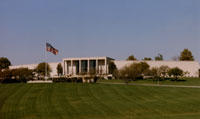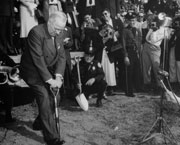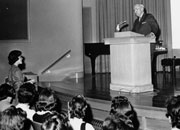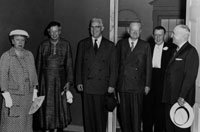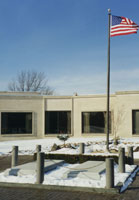Truman began planning for his library shortly after beginning his second term as President. The Harry S. Truman Library, Inc., whose purpose was to raise money for and build the library, was established in 1950. Truman initially wanted his library to be built on farm land he and his brother and sister owned in Grandview, Missouri. Other sites that were seriously suggested were the University of Kansas City (a site just to the east of Rockhill Road, at the northern edge of the university), the University of Missouri-Columbia, and the University of California at Los Angeles.
As the planning for a library sited on the Grandview farm matured, Truman apparently began to worry about the cost of providing utilities for the more or less remote site, and his brother and sister made it known they were not in favor of using the family land for the library. When Truman's brother, J. Vivian Truman, was taken to a site that one of the library's architects had selected, he looked it over and said, "Ain't no use wastin' good farmland on any old dang library." (George Elsey oral history interview, Truman Library, 1964-70.) In early 1954, Truman changed his mind and decided he wanted his library to be in Independence. The mayor and city council of Independence were supportive of Truman's wish. The initial site in Independence that Truman identified for the library, on the property of the Reorganized Church of Latter Day Saints a few blocks south and west of Truman's home at 219 North Delaware Street, was not available. The City of Independence offered instead a 16-acre site about a half mile north of Truman's home, comprised primarily of a city park. Truman liked the site. He walked around it with the mayor of Independence and some friends in August 1954. "He was just as pleased as anything I've ever seen," Truman's close friend Tom Evans, who was with him that day, remembered. "I think he was more pleased and happy about that than even he was election night in 1948, believe it or not...." (Tom L. Evans oral history interview, Truman Library, 1962-63.)
Truman insisted that fund raising for the Library not begin until he had left office, with the result that all but about $90,000 of the $1,700,000 cost of building the Library was raised between 1953 and 1957. Many Kansas City area contractors and suppliers worked without profit or with a very small profit, saving the Harry S. Truman Library, Inc. about $400,000. The library's primary architect was Edward Neild of Louisiana, who had also been the primary architect of the Jackson County courthouse in Kansas City, built by Truman when he was county judge. One of Truman's ideas for his library that did not get in the final design was that an observatory and weather station should be built on top of the Oval Office replica that was constructed just behind the main lobby.
The Harry S. Truman Library was dedicated and accepted by the government of the United States on July 6, 1957. As the ceremonies were beginning, the special guests waited in the Library's Oval Office replica, which was bare except for some simple furniture. Reporter Randall Jessee was mistakenly taken into the room, and was greatly surprised to see all the famous people sitting together. "Well, they were just sitting around in there….. I went in there and here seated all in a row-and I'll never forget-it took a good deal to startle me in those days, but just suddenly bursting in on President Hoover, Mrs. Roosevelt, Sam Rayburn, Chief Justice Warren, all that bunch sitting right there in a row did it. No one else, except all these famous figures. It looked like a wax museum…. I said, 'Oh, excuse me,' and 'Hello,' and backed out. It was such a strange experience." (Mr. and Mrs. Randall S. Jessee oral history interview, Truman Library, 1964.)
Truman worked almost every day at the library for about ten years, writing his memoirs, meeting guests, answering letters, writing speeches and articles, making a documentary film, and speaking to groups of students in the library's auditorium. The museum exhibits were focused, at Truman's insistence, not on him, but on the presidency and on American history. He wanted the library to be an educational institution, not a memorial to him. He particularly wanted to teach young people about American history. He would speak to as many as four or five student groups a day, telling them to study their history, and instructing them about the events of his presidency. "There is nothing that stimulates me so much as my sessions with students," Truman wrote. "I never miss a chance to encourage youngsters to pop questions at me." One student asked him whether it was true that he was becoming mellow and less militant politically than he had been. "Not in the slightest degree," Truman responded. "They are trying to make an elder statesman of me but they will never succeed." (Mr. Citizen, pages 171, 181.)
The library's museum opened at the time of the dedication in 1957. Over eight million people have visited it. The library's research room opened in 1959. The work of preserving, arranging, and describing Truman's papers actually began in 1953, and it continues to the present day. Over 11,000 researchers have come to the library to use Truman's papers and the 400 other collections of personal papers and government records in the library's custody. Many more people have received information about the library's holdings by mail, and more recently by fax, email, and World Wide Web.
Major additions were made to the Truman Library in about 1968, 1980, and 2000. All of the additions had the goal of building the library's museum, public, and educational programs beyond the level foreseen for them at the time of the library's founding. By the late 1990s, the library was referring to the sum of its program activity--and particularly the mostly new emphasis on interactive exhibits in the museum, educational programs for students which teach through experience and contact with original documents, and world-wide access to library materials through the Internet--as a "classroom for democracy."
Harry Truman last came to his library in December 1971. His son-in-law, Clifton Daniel, wanted him to see a new film that the library had made to show to museum visitors. It was evening and the library was empty except for the security guards. Truman saw the film, which he liked, and then walked through some of the museum exhibits. When he left the museum, he walked through a hallway in which were hung portraits of all the Presidents. He made comments to his son-in-law about one President and another and then said, "Not many of these fellows were damn fools, but those who were made a good job of it." (E. Clifton Daniel oral history interview, Truman Library, 1972.)
Truman was buried in the library's courtyard shortly after his death on December 26, 1972. Mrs. Truman was buried beside him ten years later.
The Harry S. Truman Library is located at 500 West U.S. Highway 24, Independence, MO 64050. 24-hour information line: 816-268-8200 . Administrative offices: 816-268-8200
